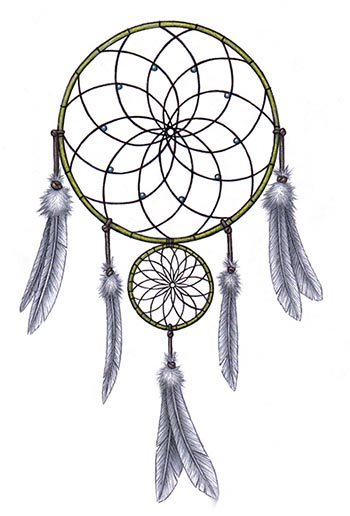

In Native American culture, a dreamcatcher is a handmade object based on a hoop (traditionally of willow), incorporating a loose net, and decorated with items unique to the particular dreamcatcher. There is a traditional belief that a dreamcatcher filters a person's dreams, letting through only the good ones. There are related legends.
While dreamcatchers originated in the Ojibwa Nation, during the Pan-Indian Movement of the 1960s and 1970s they were adopted by Native Americans of a number of different nations. Some consider the dream catcher a symbol of unity among the various Indian Nations, and a general symbol of identification with Native American or First Nations cultures. However, other Native Americans have come to see dream catchers as over-commercialized. Non-Indians have also used the dreamcatcher for their own purposes.
Traditionally, the Ojibwa construct dreamcatchers by tying sinew strands in a web around a small round or tear-shaped frame of willow (in a way roughly similar to their method for making snowshoe webbing). The resulting "dream-catcher", hung above the bed, is used as a charm to protect sleeping children from nightmares. As dreamcatchers are made of willow and sinew, they are not meant to last forever but are intended to dry out and collapse as the child enters the age of wonderment.
The Ojibwa believe that a dreamcatcher changes a person's dreams. According to Konrad J. Kaweczynski, "Only good dreams would be allowed to filter through. Bad dreams would stay in the net, disappearing with the light of day." Good dreams would pass through and slide down the feathers to the sleeper.
Another version from the same article was, "Nightmares pass through the holes and out of the window. The good dreams are trapped in the web, and then slide down the feathers to the sleeping person."
These conflicting explanations about how a dreamcatcher works may be proof of its antiquity. People keep a symbol because it is traditional, but interpret its meaning in many different ways.
In the course of becoming popular outside of the Ojibwa Nation, and then outside of the pan-Indian communities, "dreamcatchers" are now made, exhibited, and sold by some New age groups and individuals. According to Philip Jenkins, this is considered by most traditional Native peoples and their supporters to be an undesirable form of cultural appropriation.
The official portrait of Ralph Klein, former Premier of the Canadian province of Alberta and whose wife Colleen Klein is Metis, incorporates a dreamcatcher. The idea of a dream catcher was used by Margaret Salinger, daughter of J. D. Salinger, in her book of memoirs about her father, Dream Catcher: A Memoir.
Dreams -- Throughout history, nearly every person and culture has placed importance on the meanings of dreams - archetypical messages from 'the other side' - given by various sources - that must interpreted by their symbology and content. Today, dreams are still a powerful force in many people's lives, particularly because of the meanings that can be found in them. Whether dreams are good or bad, they can inspire, confuse, or upset the dreamer.
In the Ojibway tribe, night visions, or dreams, were so important that children were not given a name until after a person designated as the "namer" of that child had a dream as to what he/she should be called. The namer might give the child a charm woven to look like a spider's web in order to protect the baby's dreams.
See Spider Woman.
Dreamcatchers are an authentic American Indian tradition, from the Ojibway (Chippewa) tribe. The people would tie sinew strands in a web around a small round or tear-shaped frame - in a somewhat similar pattern to how they tied webbing for Ojibway snowshoes--and hang this "dream-catcher" as a charm to protect sleeping children from nightmares. The legend is that the bad dreams will get caught in the web.
The Dreamcatcher allegedly helps us remember our dreams. It is regarded by some as a serious tool that is much more than a decorative ornament. The opening in the center determines the volume that you are asking to receive and parallels the changes that will occur in your life.
Hang the dreamcatcher near the place where you sleep, on the wall, or perhaps from a lampshade or bedpost. Should your dreams become too active, or if you feel you need a break from the workings of your dreamcatcher, simply lay it down on a flat surface to render it inactive until you are ready to hang it up again. Beads, feathers and fetishes are not appropriate on a dreamcatcher as they interfere with the spiraling motion and can cause disturbing dreams.
Long ago in the ancient world of the Ojibwe Nation, the Clans were all located in one general area of that place known as Turtle Island.
This is the way that the old Ojibwe storytellers say how Asibikaashi Spider Woman helped Wanabozhoo bring giizis (sun) back to the people.
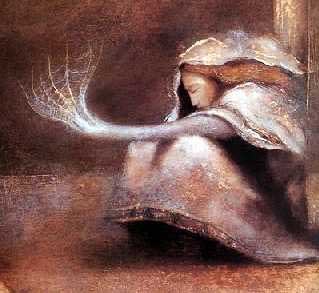
To this day, Asibikaashi will build her special lodge before dawn. If you are awake at dawn, as you should be, look for her lodge and you will see this miracle of how she captured the sunrise as the light sparkles on the dew which is gathered there.
Asibikaasi took care of her children, the people of the land, and she continues to do so to this day.
When the Ojibwe Nation dispersed to the four corners of North America, to fill a prophecy, Asibikaashi had a difficult time making her journey to all those cradle boards, so the mothers, sisters, and Nokomis (grandmothers) took up the practice of weaving the magical webs for the new babies using willow hoops and sinew or cordage made from plants.
It is in the shape of a circle to represent how giizistravels each day across the sky.
The dream catcher will filter out all the bad bawedjigewin (dreams) & allow only good thoughts to enter into our minds when we are just abinooji. You will see a small hole in the center of each dream catcher where those good bawadjige may come through. With the first rays of sunlight, the bad dreams would perish.
When we see little asibikaashi, we should not fear her, but instead respect and protect her. In honor of their origin, the number of points where the web connected to the hoop numbered 8 for Spider Woman's eight legs or 7 for the Seven Prophecies.
It was traditional to put a feather in the center of the dream catcher; it means breath, or air.
It is essential for life. A baby watching the air playing with the feather on her cradleboard was entertained while also being given a lesson on the importance of good air.
This lesson comes forward in the way that the feather of the owl is kept for wisdom (a woman's feather) and the eagle feather is kept for courage (a man's feather). This is not to say that the use of each is restricted by gender, but that to use the feather each is aware of the gender properties she/he is invoking. (Indian people, in general, are very specific about gender roles and identity.)
The use of gemstones, as we do in the ones we make for sale, is not something that was done by the old ones. Government laws have forbidden the sale of feathers from our sacred birds, so using four gemstones, to represent the four directions, and the stones used by western nations were substituted by us.
Long ago when the world was young, an old Lakota spiritual leader was on a high mountain and had a vision.
In his vision, Iktomi, the great trickster and teacher of wisdom, appeared in the form of a spider.
Iktomi spoke to him in a sacred language that only the spiritual leaders of the Lakota could understand.
As he spoke Iktomi, the spider, took the elder's willow hoop which had feathers, horse hair, beads and offerings on it and began to spin a web.
He spoke to the elder about the cycles of life ... and how we begin our lives as infants and we move on to childhood, and then to adulthood. Finally, we go to old age where we must be taken care of as infants, completing the cycle.
"But," Iktomi said as he continued to spin his web, "in each time of life there are many forces -- some good and some bad. If you listen to the good forces, they will steer you in the right direction. But if you listen to the bad forces, they will hurt you and steer you in the wrong direction."
He continued, "There are many forces and different directions that can help or interfere with the harmony of nature, and also with the great spirit and-all of his wonderful teachings."
All the while the spider spoke, he continued to weave his web starting from the outside and working toward the center.
When Iktomi finished speaking, he gave the Lakota elder the web and said..."See, the web is a perfect circle but there is a hole in the center of the circle."
He said, "Use the web to help yourself and your people to reach your goals and make good use of your people's ideas, dreams and visions.
"If you believe in the great spirit, the web will catch your good ideas -- and the bad ones will go through the hole."
The Lakota elder passed on his vision to his people and now the Sioux Indians use the dream catcher as the web of their life.
It is hung above their beds or in their home to sift their dreams and visions.
The good in their dreams are captured in the web of life and carried with them...but the evil in their dreams escapes through the hole in the center of the web and are no longer a part of them.
They believe that the dream catcher holds the destiny of their future.
Materials:
5 inch ring
4 yds Suede Lacing
1/8inch 3yds Sinew (waxed nylon string)
1 Small Concho
12 Pony Beads
16 Pony Beads
Feathers
Scissors
Glue
Clothes Pin
If you cannot obtain the supplies, try making one using a small green branch from a tree about 1 cm in diameter and 1 meter long. Just bind the ends of the branch together and then make the web in the same way.
This is just one way to make dreamcatchers, I make many different styles, and no two ever look exactly the same. Be creative, and see how many different ones your can make.
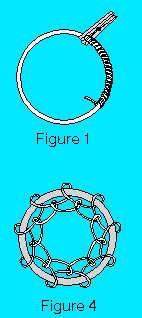
1. Cut 8 ft. of the suede lacing. Glue one end of the lacing to the ring. Wrap the suede lacing around the ring until you reach the starting point again. Be careful not to twist the lacing. Glue the end of the lacing to the ring. Hold it in place with a clothespin until the glue dries (Figure 1).
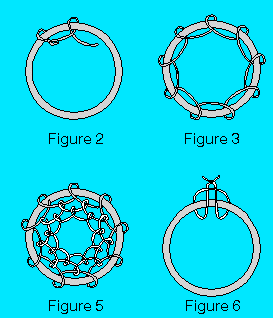
2. To make the web, tie one end of the immitation sinew to the ring (Figure 2). Make nine half hitch knots around the ring spacing them about 1-1/2" apart (Figure 3). Make the last hitch a little closer to the first knot as this prevents a large gap from forming. Keep the thread pulled snug between the knots.
3. Begin the next row of the web in the middle of the thread that you have already weaved on row 1.(Figure 4). Continue weaving in the same way until you have a small hole left in the center. Tie a double knot in the cord, add a tiny drop of glue to the knot and cut off remaining thread when dry. (Figures 5 & 6).
4. To make the loop to hang your Dream Catcher, use a 12" piece of suede lacing. Fold it in half and tie a knot in the open end. At the top of the ring, attach the lacing by slipping the loop end through the ring and then around the ring and over the knot. Pull the lacing tight to secure it in place.
5. To make the hanging sections, cut three 8" pieces of suede Tie two 8" pieces of suede lacing about one third of the way up each side of the ring using a double knot. Slip 3 colored pony beads onto each piece of lacing and secure with a knot.
6. Using the last 8" piece of lacing to attach small concho to top middle of the ring. Slip three pony beads onto each piece of lacing.
7. Finally, push two feathers up inside the beads on each piece of lacing except the one hanging from the concho. Glue the feathers if they are loose. The last 4 feathers are attatched 2 each side of the concho.
To make larger sizes : 12 inch rings needs approx. 7 yds of 1/8 suede lacing to bind it 9 inch ring - 6 yds 6 inch ring - 4 yds Remember that you will need extra suede for the laces and hanger.
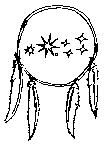
Dream catchers made of willow and sinew are for children, and they are not meant to last.
Eventually the willow dries out and the tension of the sinew collapses the dream catcher. That's
supposed to happen. It belies the temporary-ness of youth. Adults should use dream catchers of
woven fiber which is made up to reflect their adult "dreams." It is also customary in many parts of
Canada and the Northeastern U.S. to have the dream catchers be a tear-drop/snow shoe shape.

Dreams